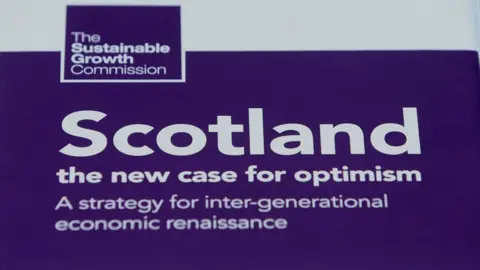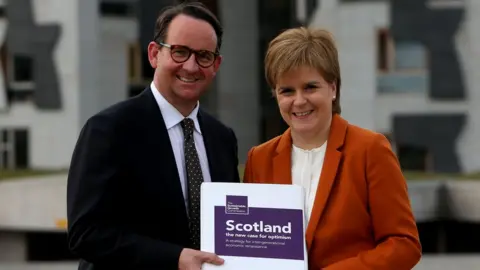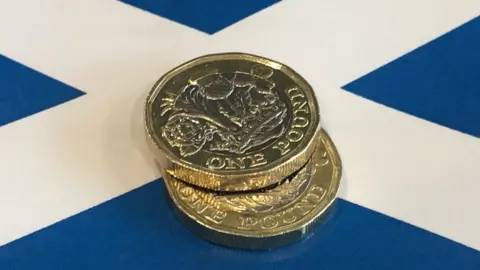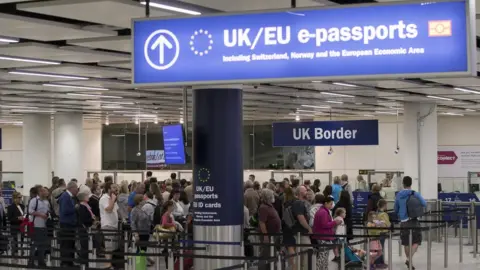What's in the SNP's growth commission report?
 PA
PAThe SNP has published its "growth commission" report on the economics of an independent Scotland. The 354-page report runs through 50 recommendations on a range of fiscal subjects - but what are the key messages?

The basis
Andrew Wilson's commission has sought to give their report a sound basis in current economic conventions - including some which were used as a stick to beat the 2014 White Paper.
To start with, it accepts the GERS figures - the annual estimate of the Scottish economy as part of the United Kingdom which has frequently infuriated the pro-independence side - as a starting point.
It has used figures and adapted modelling approaches from a range of economic experts and institutions, from the Office for National Statistics to the Institute for Fiscal Studies.
It has also made no assumptions about Brexit or EU membership, or any timeline for when an independence referendum might be held.
The vision the commission's report sets out is of a lengthy, orderly transition to independence - learning lessons from the ongoing Brexit negotiations.
The plan is that Scotland would leave on good terms with the rest of the UK, and retain strong economic links - including the pound, for at least a decade, and close links to financial and trade systems.

Day one
 PA
PAThe report is based on the idea that an independent Scottish state would cost about £450m to set up. This figure was provided by Prof Patrick Dunleavy from the London School of Economics.
The commission reckon that an independent Scotland would start out with an annual budget deficit of just under 6%, having adjusted for things like reduced defence spending and debt-servicing costs.
This deficit rate would then be whittled down over subsequent years via sensible budgeting - although not by austerity, which is seen as being counter-productive.
The model set out in the report reckons this will really start to make a difference in about year four post-independence, and that the deficit will be under control - so under 3% of GDP per year - by year ten.
There is also a pledge that while running a deficit in the early years, Scotland wouldn't allow a pile of new debt to accumulate above the value of 50% of GDP.

Honouring debts
The commission is clear that while an independent Scotland would not start out with any debt of its own, it would honour its "historic" commitment to the UK's existing national debt.
This would happen via an "Annual Solidarity Payment" of £5bn a year, to go towards previous UK debt and shared commitments such as international aid.
£5bn a year sounds like a lot in the first instance, but the report argues that after a generation or so of inflation and economic growth it would represent a dwindling share of Scotland's GDP.

Currency

The key proposal of the commission is that Scotland would retain the pound for a lengthy transition period after independence.
This is slightly different from the currency union that Alex Salmond was hoping for in the 2014 referendum, and would mean Scotland would have to accept the monetary policy laid down by the Bank of England.
The country would then only look to move to its own currency once six stringent tests have been met - including stable public finances, a sound central bank, certainty for businesses and residents and stable foreign exchange rates.
The plan is that this will maximise stability and continuity - and will provide voters with as much certainty as possible when it comes to their pensions and mortgages.

Banking
Linked to the issue of currency is that of banking, given the Bank of England would continue to set interest rates and monetary policy for the pound, as long as Scotland continued to use it.
A Scottish central bank would still be set up to hold deposits and act as a lender of last resort - not so much to prop up banks as to mitigate any impact on the wider economy of any bank getting into trouble.
The commission broadly assumes that the big banks would move their headquarters to London post-independence to stay in with the current regulatory regime - although they hope that this might not cost many jobs, as local branches and other companies would stay in Scotland.
There would be a Scottish financial regulator, mirroring the UK system - again in a bid to provide as much certainty and stability for businesses as possible.

Immigration
 Getty Images
Getty ImagesAn open migration policy growing Scotland's population is absolutely key to the prospectus.
The report states that as it stands, the 429,000 people from outwith the UK who live in Scotland make a net contribution of £1.3bn per year and pay in £4.3bn in tax and other contributions. The aim is to grow the first figure, and watch the second two rise in turn.
A series of incentives are set out to achieve this, from "transition relief" tax cuts for highly skilled migrant workers to a new, easy to use visa system.

Sustainable finances
The commission's drive for sustainable public finances is underpinned by "the three Ps" - population, participation and productivity. The first of the three is covered by the "immigration" section above.
Participation includes measures to tackle the ingrained inequalities in society, starting with the gender pay gap. The report endorses a "flexible" labour market, with the state intervening to help unemployed people into sustainable jobs.
Productivity is a difficult issue for many economies, and requires a long-term effort. The commission suggests a particular focus on exports.
It also promotes a "stop strategy" - an acceptance that there might be too many economic strategies kicking about at the moment, and that more peripheral work which makes less of an impact should just be scrapped, in favour of a more focused approach.
All of this would be combined with disciplined spending - always remaining at least 1% below the rate of growth of the economy - to get the starting deficit down to a manageable level.

International comparisons
 New Zealand parliament
New Zealand parliamentThe report has studied a dozen successful small countries around the world, with input from various international experts.
They are: Austria, Belgium, Denmark, Finland, Hong Kong, Ireland, the Netherlands, New Zealand, Norway, Singapore, Sweden and Switzerland.
Lessons have been learned from Denmark, Finland and New Zealand in particular, with the commission arguing that small countries have actually outperformed their larger peers in terms of economic growth over the last 25 years.
The report says the UK economic model in particular is "unsustainable", and is effectively "flying on one engine" driven hugely by London and the south east. The argument is that small independent countries are more agile when it comes to navigating the waters of the global economy.

Future investment
What's missing from the report so far, that you might remember from the 2014 White Paper?
You guessed it - oil. Mr Wilson is determined that oil will not be "baked into the numbers" as it was in 2014, and will be treated strictly as a bonus.
Any profits from the oil and gas industry and any other "windfalls" will be channelled into a "fund for future generations".
This basically means taking bets on long-term investment projects, which might not pay off for a generation or more - ranging from education projects to infrastructure and green energy.
